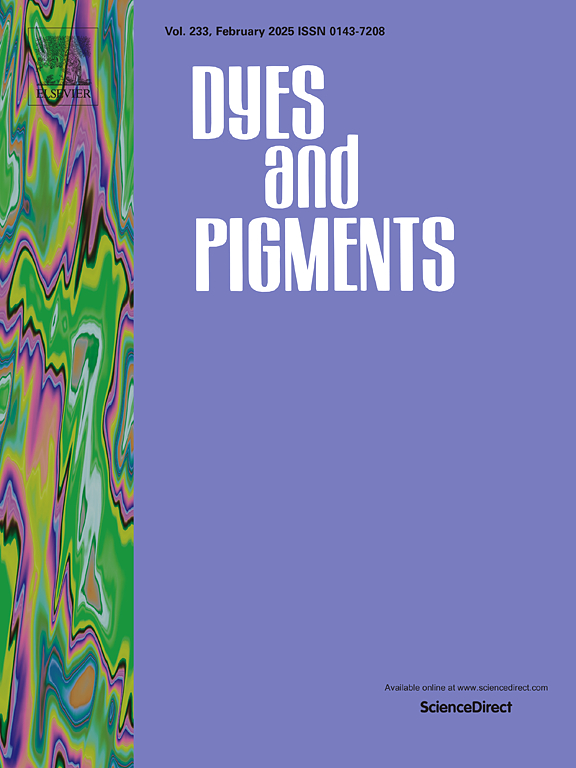A carrier-free rigid fluorescent small molecule CF3/S-containing BODIPY probe: Design and synthesis, tumor cell imaging and biological activity evaluation
IF 4.1
3区 工程技术
Q2 CHEMISTRY, APPLIED
引用次数: 0
Abstract
Excellent photophysical characteristics and structural modifiability characterize BODIPY fluorescent probes. In this study, A carrier-free rigid fluorescent small molecule CF3/S-containing BODIPY probe (BODIPY-CF3/S) was designed and synthesized by introducing benzothiophene groups and trifluoromethane groups into the probe structure. By using the benzene ring large conjugate system to modify the parent structure of BODIPY, a rigid conjugate structure with large π-bonds was formed, improving the photophysical characteristics, increasing the fluorescence wavelength, and improving the intensity and stability of the fluorescence emission. The introduction of benzene ring system and trifluoromethane group makes the probe have good fat solubility. Solvent evaporation was used to create single crystals, and the rigid large conjugate structure of the crystals was seen. Following testing, the probe's photophysical characteristics at various pH values held up well and were largely stable. The BODIPY-CF3/S fluorescent marker exhibits good biocompatibility with both HCT-116 and HeLa tumor cells, and can enter the cell interior without any carrier due to its excellent fat solubility. Its ability to emit a distinct green fluorescent signal makes it useful for follow-up observation and visualization. As such, it has potential applications as a fluorescent marker. In addition, in vitro cytotoxicity studies, the probe showed good inhibition on A549 cancer cells and HCT-116 cancer cells. In summary, the prepared BODIPY-CF3/S fluorescent probe has the advantages of long wavelength, strong conjugation stability, good photophysical quality, no carrier and strong fat solubility. These attributes will give researchers and designers of BODIPY rigid conjugated fluorescent probes new ideas for their future research and development.

含CF3/ s的无载体刚性荧光小分子BODIPY探针:设计合成、肿瘤细胞成像及生物活性评价
BODIPY荧光探针具有优良的光物理特性和结构可修饰性。本研究通过在探针结构中引入苯并噻吩基团和三氟甲烷基团,设计合成了一种无载体刚性荧光小分子CF3/S BODIPY探针(BODIPY-CF3/S)。通过苯环大共轭体系修饰BODIPY的母体结构,形成了具有大π键的刚性共轭结构,改善了光物理特性,增加了荧光波长,提高了荧光发射的强度和稳定性。苯环体系和三氟甲烷基团的引入使探针具有良好的脂溶性。采用溶剂蒸发法制备单晶,晶体具有刚性的大共轭结构。经过测试,探测器在不同pH值下的光物理特性保持良好,并且基本稳定。BODIPY-CF3/S荧光标记物与HCT-116和HeLa肿瘤细胞均具有良好的生物相容性,并且由于其良好的脂溶性,无需任何载体即可进入细胞内部。它能够发出独特的绿色荧光信号,这对后续观察和可视化很有用。因此,它作为荧光标记物具有潜在的应用前景。此外,在体外细胞毒性研究中,该探针对A549癌细胞和HCT-116癌细胞表现出良好的抑制作用。综上所述,制备的BODIPY-CF3/S荧光探针具有波长长、共轭稳定性强、光物理质量好、无载流子、脂溶性强等优点。这些特性将为BODIPY刚性共轭荧光探针的研究和设计提供新的思路。
本文章由计算机程序翻译,如有差异,请以英文原文为准。
求助全文
约1分钟内获得全文
求助全文
来源期刊

Dyes and Pigments
工程技术-材料科学:纺织
CiteScore
8.20
自引率
13.30%
发文量
933
审稿时长
33 days
期刊介绍:
Dyes and Pigments covers the scientific and technical aspects of the chemistry and physics of dyes, pigments and their intermediates. Emphasis is placed on the properties of the colouring matters themselves rather than on their applications or the system in which they may be applied.
Thus the journal accepts research and review papers on the synthesis of dyes, pigments and intermediates, their physical or chemical properties, e.g. spectroscopic, surface, solution or solid state characteristics, the physical aspects of their preparation, e.g. precipitation, nucleation and growth, crystal formation, liquid crystalline characteristics, their photochemical, ecological or biological properties and the relationship between colour and chemical constitution. However, papers are considered which deal with the more fundamental aspects of colourant application and of the interactions of colourants with substrates or media.
The journal will interest a wide variety of workers in a range of disciplines whose work involves dyes, pigments and their intermediates, and provides a platform for investigators with common interests but diverse fields of activity such as cosmetics, reprographics, dye and pigment synthesis, medical research, polymers, etc.
 求助内容:
求助内容: 应助结果提醒方式:
应助结果提醒方式:


